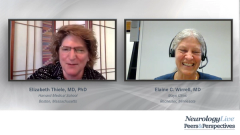
Promising Therapies for Dravet and Lennox-Gastaut Syndromes
Two experts list new therapies being developed for the treatment of Dravet and Lennox-Gastaut syndromes.
Episodes in this series

Elizabeth Thiele, MD, PhD: As we were talking earlier, you used the word precision medicine. So now we have FDA approved medications in Dravet and in LGS [Lennox-Gastaut syndrome]. Since LGS is many different ideologies, it’s hard to think of 1 or more specific or precision therapies can we have there except for the underlying etiologies. But what do you think is in the pipeline, that’s exciting, especially in the world of Dravet syndrome?
Elaine C. Wirrell, MD: There’s a couple of things that are coming down the pipelines that are very exciting, and those are the therapies that are targeting the underlying pathogenesis. One of those that’s currently in clinical trials, that is an antisense oligonucleotide, and that has been shown in mouse models to restore normal levels of the NaV1.1 protein. Also, very exciting in the mouse model was the reduction in mortality, the SUDEP [sudden unexpected death in epilepsy], like mortality. That was exciting. That’s currently being used in clinical trials. That’s a therapy that needs to be given interest equally. It’s not going to be a one and done. These are kids that are going to have to get this therapy, and we don’t know yet how frequently that’s going to be and maybe it’s every 4 months or every 6 months, but they will require additional continued therapy. The hope there is that if it addresses the problem with the SCN1A channel, that it will not only improve seizures, but also significantly reduce comorbidity. Attenuate some of that significant developmental concerns that we see with children with Dravet syndrome over the long term. It’s exciting to see where those clinical trials are going. The other therapy is not yet in clinical trials, although there’s been some discussion about that. It’s a gene therapy. That will be a one and done therapy that has been studied in animal models. They have been able to target that therapy to the GABAergic interneurons, where the pathology is, and Dravet syndrome. Because the SCN1A gene is large and they can’t put the whole gene into the adenovirus vector, but what they’ve done is a promoter. That has been shown to significantly alleviate seizures and reduce mortality in an animal model. That likely will be coming in the next year or 2 into clinical trials in humans.
Elizabeth Thiele, MD, PhD: We’re all excited about that. I know the patient community is excited about that. Several years ago, I was at an epilepsy foundation sponsored meeting on the future in pediatric trials and where are we going, and they were represented as a medical community of the patient advocacy groups of the FDA, DEA [Drug Enforcement Administration], etcetera. I was there advocating that my patient population is largely refractory epilepsy population. I need treatments for many of them, a lot wider than these specific syndromes. It was a father with a child with Dravet [syndrome] made a very impassioned argument that said, “Yes, I care about everyone living with epilepsy, but I care about my child with Dravet syndrome, and I’m treating symptoms right now. Epilepsy is a symptom of this disorder, and I want more specific treatments.” There is a huge amount of excitement about that. Big things are happening. Are you excited about any kind of medications that you know, or in the pipeline for either LGS or for Dravet? I know our focus has been on these ones we have now because we’re excited, we’re still getting used to using them and putting patients on them. The reality is, we’re going to have an unmet need for effective treatments. Is there anything else that you’re interested in the works for either patients living with LGS or Dravet?
Elaine C. Wirrell, MD: For Dravet that clemizole and lorcaserin [Belviq] are going to be in or are in clinical trials. Those have potential to benefit some of the children with Dravet syndrome. They’re not precision therapy. Again, we’re going to be targeting probably more seizures than the other symptoms that go along with that. Soticlestat has also been looked at for Dravet syndrome and Lennox-Gastaut [syndrome] and again, some modest efficacy and certainly greater than placebo in Dravet syndrome. It’s a novel mechanism of action and that’s interesting and that does provide promise to some children with these conditions. It’s not precision therapy that’s going to target, improved development and addressing other comorbidities as well. From a personal standpoint, those have benefits and likely will benefit some patients with Dravet and LGS, but I’m more excited about the precision therapies where they will also address the comorbidities. I should mention that fenfluramine [Fintepla] it also has been shown to be beneficial for LGS. In the subgroup that is having frequent tonic-clonic seizures, it may be even more helpful for that subgroup, but not yet FDA approved.
Elizabeth Thiele, MD, PhD: I agree. The LGS trial didn’t have the efficacy in fenfluramine Dravet, but I don’t think that means it’s not going to be an important medication for Dravet. In fact, I have more patients on fenfluramine off-label than I do with Dravet and many kids benefiting from it, so definitely. The other thing, we talked about the open-label extension data, because data that comes from those trials is important. Granted, it’s open-label, but these patients are still tracking seizures or being closely followed, etcetera. The open-label extension to trial from fenfluramine. That again, showed continued efficacy, safety, and tolerability. The other thing that I thought was exciting about the data from that trial was looking at executive function in the super-responders because there’s been this debate in the Dravet world or the intellectual disability and the epilepsy, just comorbidities are they confounding? I’ve always had the feeling that the epilepsy has got to be impacting them now. The fact that they take the super-responders from that trial that had a greater than 75% reduction in seizures and showed during that open-label extension, they had improvements, that meant a lot to us, it also meant a lot to the patient community. Do you have anything else that’s striking from the open-label and real-world experience with fenfluramine?
Elaine C. Wirrell, MD: Again, the 0 cardiac side effects. I can’t rule it out completely, but these are our kids that were treated for a median of a year and a half on fenfluramine. It was a large group, over 300 kids, treated for a prolonged time, monitored carefully, and no cardiac side effects. That’s very reassuring. Anytime we started treatment, it’s a balance. You’re balancing the potential for side effects and the benefit you get. The benefit we see with this medication, in my view, is outweighing the rare potential for cardiac side effects.
Elizabeth Thiele, MD, PhD: I agree. It makes me feel old. Not only do I tell my families about the royal decree in Belgium, but I tell them, don’t you remember fen-phen [fenfluramine-phentermine]? A lot of the parents of my Dravet kids, I don’t think were even alive when we all learned…but it’s still important to tell the history and why we’re getting the echocardiograms, and they’re very important that there has been no safety signal so far at all with regard to cardiac.
This transcript has been edited for clarity.
Newsletter
Keep your finger on the pulse of neurology—subscribe to NeurologyLive for expert interviews, new data, and breakthrough treatment updates.
































